Determination of Young Elasticity Modulus in Bored Piles Through the Global Strain Extensometer Sensors and Real-Time Monitoring Data
Abstract
1. Introduction
2. Material and Methods
2.1. Testing
2.2. Loading Procedure
2.3. Instruments Monitoring System
2.4. Site Condition
3. Results and Discussion
3.1. Stress–Strain Variation in the Piles
3.2. Pile Movement Monitoring
4. Conclusions
- ○
- Distribution of concrete modulus has been measured from the stress–strain behavior of tested piles and using back analysis. In BP# 1, along with the pile, the value is almost constant at 25 kN/mm2, however, this value is between 30 and 45 kN/mm2 in BP# 2. This has indicated that the applied stress is the dominant factor in alteration because of the various soil reaction systems responding to the stresses released from the pile. The maximum change has been measured at the pile’s head where the maximum stresses have been recorded, in contrast, variation at the pile’s toe is negligible since the least stresses have been applied in the pile base. The stresses of the pile have been declined by the depth because the skin friction of the pile has carried a large portion of applied load in the pile. Maximum permanent (plastic) deformations of 24.63 mm and 19.54 mm have been measured in the pile head for BP# 1 & BP# 2 correspondent to applied stresses of 17305 kPa (p = 44306 kN) and 16430 kPa (p = 12905 kN). The pile top settlement has been rebounded to a residual value of 2.4 mm and 8.55 mm in BP# 1 & BP# 2 after unloading to zero.
- ○
- The obtained result will be helpful for real-time assessment of bored pile during its service life. However, this should be noted that due to the heterogeneous characteristics of the soil, the measured Ec of the tested soil may vary. Variables such as concrete maturity, piling technology, soil parameters, and groundwater level can have a significant influence on the soil-pile interactions as well as concrete pile characteristics.
Author Contributions
Funding
Conflicts of Interest
List of Abbreviations
| CAPWAP | control and provisioning of wireless access points |
| shaft diameter | |
| FE | finite element |
| FRP | fiber-reinforced plastic |
| GI | galvanized iron |
| GSE | global strain extensometer |
| HSDT | high strain dynamic testing |
| L | length |
| LVDTs | linear variation displacement transducers |
| MARS | multivariate adaptive regression spline |
| MLT | maintained load test |
| PSE | pile structure embankments |
| SPT | standard penetration test |
| SPT-N | standard penetration test—number of blows |
| TBM | tunnel boring machine |
| VWLC | vibrating wire load cells |
| VWSG | vibrating wire strain gauges |
References
- Tomlinson, M.J.; Woodward, J. Pile Design and Construction Practice; Taylor & Francis: Boca Raton, FL, USA, 2003. [Google Scholar]
- Badrun, M. Prediction of Ultimate Bored Pile Capacity Using Global Strain Extensometer. Master’s Thesis, Faculty of Civil Engineering, Universiti Teknologi Malaysia, Skudai, Malaysia, 2011. [Google Scholar]
- Moayedi, H.; Hayati, S. Artificial intelligence design charts for predicting friction capacity of driven pile in clay. Neural Comput. Appl. 2018, 1–17. [Google Scholar] [CrossRef]
- Moayedi, H.; Nazir, R.; Mosallanezhad, M. Determination of reliable stress and strain distributions along bored piles. Soil Mech. Found. Eng. 2015, 51, 285–291. [Google Scholar] [CrossRef]
- Barr, L.; Wong, R.C.K. Shaft resistance of bored cast-in-place concrete piles in oil sand—Case study. Geomech. Eng. 2013, 5, 119–142. [Google Scholar] [CrossRef]
- Coduto, R. Foundation Design Principles And Practices; Prentice Hall: Englewood Cliffs, NJ, USA, 2001. [Google Scholar]
- Omer, J.R.; Delpak, R.; Robinson, R.B. An Empirical Method for Analysis of Load Transfer and Settlement of Single Piles. Geotech. Geol. Eng. 2010, 28, 483–501. [Google Scholar] [CrossRef]
- Fellenius, B.H.; Kim, S.R.; Chung, S.G. Long-term monitoring of strain in instrumented piles. J. Geotech. Geoenviron. Eng. 2009, 135, 1583–1595. [Google Scholar] [CrossRef]
- Moayedi, H.; Nazir, R.; Mosallanezhad, M.; Noor, R.B.M.; Khalilpour, M. Lateral deflection of piles in a multilayer soil medium. Case study: The Terengganu seaside platform. Measurement 2018, 123, 185–192. [Google Scholar] [CrossRef]
- Mosallanezhad, M.; Moayedi, H. Developing hybrid artificial neural network model for predicting uplift resistance of screw piles. Arab. J. Geosci. 2017, 10, 479. [Google Scholar] [CrossRef]
- Nazir, R.; Moayedi, H.; Mosallanezhad, M.; Tourtiz, A. Appraisal of reliable skin friction variation in a bored pile. Proc. Inst. Civ. Eng.-Geotech. Eng. 2015, 168, 75–86. [Google Scholar] [CrossRef]
- Nazir, R.; Moayedi, H.; Subramaniam, P.; Gue, S.-S. Application and Design of Transition Piled Embankment with Surcharged Prefabricated Vertical Drain Intersection over Soft Ground. Arab. J. Sci. Eng. 2018, 43, 1573–1582. [Google Scholar] [CrossRef]
- Niroumand, H.; Kassim, K.A.; Nazir, R.; Faizi, K.; Adhami, B.; Moayedi, H.; Loon, W. Slope stability and sheet pile and contiguous bored pile walls. Electron. J. Geotech. Eng. 2012, 17, 19–27. [Google Scholar]
- Brown, M.J.; Hyde, A.F.L.; Anderson, W.F. Analysis of a rapid load test on an instrumented bored pile in clay. Geotechnique 2006, 56, 627–638. [Google Scholar] [CrossRef]
- Brown, D.A.; O’Neill, M.W.; Hoit, M.; McVay, M.; El Naggar, M.H.; Chakraborty, S. Static and Dynamic Lateral Loading of Pile Groups; Transportation Research Board: Washington, DC, USA, 2001. [Google Scholar]
- Boulanger, R.W.; Curras, C.J.; Kutter, B.L.; Wilson, D.W.; Abghari, A. Seismic soil-pile-structure interaction experiments and analyses. J. Geotech. Geoenviron. Eng. 1999, 125, 750–759. [Google Scholar] [CrossRef]
- Gao, W.; Dimitrov, D.; Abdo, H. Tight independent set neighborhood union condition for fractional critical deleted graphs and ID deleted graphs. Discret. Contin. Dyn. Syst. Ser. 2018, 12, 711–721. [Google Scholar] [CrossRef]
- Moayedi, H.; Mosallanezhad, M.; Nazir, R. Evaluation of Maintained Load Test (MLT) and Pile Driving Analyzer (PDA) in Measuring Bearing Capacity of Driven Reinforced Concrete Piles. Soil Mech. Found. Eng. 2017, 54, 150–154. [Google Scholar] [CrossRef]
- Moayedi, H.; Nazir, R.; Ghareh, S.; Sobhanmanesh, A.; Tan, Y.C. Performance analysis of piled-raft foundation system of varying pile lengths in controlling angular distortion. Soil Mech. Found. Eng. 2018, 55, 265–269. [Google Scholar] [CrossRef]
- Gao, W.; Guirao, J.L.G.; Abdel-Aty, M.; Xi, W. An independent set degree condition for fractional critical deleted graphs. Discret. Contin. Dyn. Syst. Ser. 2019, 12, 877–886. [Google Scholar] [CrossRef]
- Hutchins, N.; Choi, K.S. Accurate measurements of local skin friction coefficient using hot-wire anemometry. Prog. Aerosp. Sci. 2002, 38, 421–446. [Google Scholar] [CrossRef]
- Ng, K.W.; Sritharan, S. A procedure for incorporating setup into load and resistance factor design of driven piles. Acta Geotech. 2016, 11, 347–358. [Google Scholar] [CrossRef]
- Hung, L.C.; Nguyen, T.D.; Lee, J.H.; Kim, S.R. Applicability of CPT-based methods in predicting toe bearing capacities of driven piles in sand. Acta Geotech. 2016, 11, 359–372. [Google Scholar] [CrossRef]
- Tafreshi, S.N.M.; Javadi, S.; Dawson, A.R. Influence of geocell reinforcement on uplift response of belled piles. Acta Geotech. 2014, 9, 513–528. [Google Scholar] [CrossRef]
- Mascarucci, Y.; Miliziano, S.; Mandolini, A. A numerical approach to estimate shaft friction of bored piles in sands. Acta Geotech. 2014, 9, 547–560. [Google Scholar] [CrossRef]
- Lee, C.; An, S.; Lee, W. Real-time monitoring of SPT donut hammer motion and SPT energy transfer ratio using digital line-scan camera and pile driving analyzer. Acta Geotech. 2014, 9, 959–968. [Google Scholar] [CrossRef]
- Ochiai, H.; Otani, J.; Matsui, K. Performance factor for bearing resistance of bored friction piles. Struct. Saf. 1994, 14, 103–130. [Google Scholar] [CrossRef]
- Poulos, H.G. Piled raft foundations: Design and applications. Geotechnique 2001, 51, 95–113. [Google Scholar] [CrossRef]
- Sego, D.C.; Biggar, K.W.; Wong, G. Enlarged base (belled) piles for use in ice or ice-rich permafrost. J. Cold Reg. Eng. 2003, 17, 68–88. [Google Scholar] [CrossRef]
- Shariatmadari, N.; Eslami, A.; Karimpour-Fard, M. Bearing capacity of driven piles in sands from SPT-applied to 60 case histories. Iran. J. Sci. Technol. Trans. B-Eng. 2008, 32, 125–140. [Google Scholar]
- Zhang, Q.Q.; Zhang, Z.M.; He, J.Y. A simplified approach for settlement analysis of single pile and pile groups considering interaction between identical piles in multilayered soils. Comput. Geotech. 2010, 37, 969–976. [Google Scholar] [CrossRef]
- Ruan, X.; Zuo, R.Y. Research on the Relationship between SPT and the ultimate vertical bearing capacity of jacked pile in Shenyang district. In Frontiers of Green Building, Materials and Civil Engineering, Pts 1-8; Sun, D., Sung, W.P., Chen, R., Eds.; Trans Tech Publications Ltd.: Stafa-Zurich, Switzerland, 2011; Volume 71–78, pp. 3308–3311. [Google Scholar]
- Samui, P. Multivariate adaptive regression spline applied to friction capacity of driven piles in clay. Geomech. Eng. 2011, 3, 285–290. [Google Scholar] [CrossRef]
- Samui, P. Determination of ultimate capacity of driven piles in cohesionless soil: A Multivariate Adaptive Regression Spline approach. Int. J. Numer. Anal. Methods Geomech. 2012, 36, 1434–1439. [Google Scholar] [CrossRef]
- Chae, D.; Cho, W.; Na, H.Y. Uplift Capacity of Belled Pile in Weathered Sandstones. Int. J. Offshore Polar Eng. 2012, 22, 297–305. [Google Scholar]
- Sakr, M. Comparison between high strain dynamic and static load tests of helical piles in cohesive soils. Soil Dyn. Earthq. Eng. 2013, 54, 20–30. [Google Scholar] [CrossRef]
- Zhang, Q.Q.; Zhang, Z.M.; Li, S.C. Investigation into Skin Friction of Bored Pile Including Influence of Soil Strength at Pile Base. Mar. Geores. Geotechnol. 2013, 31, 1–16. [Google Scholar] [CrossRef]
- Yao, W.J.; Chen, S.P. Elastic-plastic analytical solutions of deformation of uplift belled pile. Teh. Vjesn. 2014, 21, 1201–1211. [Google Scholar]
- Aksoy, H.S.; Gor, M.; Inal, E. A new design chart for estimating friction angle between soil and pile materials. Geomech. Eng. 2016, 10, 315–324. [Google Scholar] [CrossRef]
- Wang, C.D.; Zhou, S.H.; Wang, B.L.; Guo, P.J.; Su, H. Settlement behavior and controlling effectiveness of two types of rigid pile structure embankments in high-speed railways. Geomech. Eng. 2016, 11, 847–865. [Google Scholar] [CrossRef]
- Tosini, L.; Cividini, A.; Gioda, G. A numerical interpretation of load tests on bored piles. Comput. Geotech. 2010, 37, 425–430. [Google Scholar] [CrossRef]
- Zhang, R.K.; Shi, M.L.; Wang, J. Settlement Analysis of Single Large-Diameter and Super-Long Bored Piles in Cohesive Soils. Adv. Mater. Res. 2012, 594, 320–326. [Google Scholar] [CrossRef]
- Xu, M.J.; Ni, P.P.; Mei, G.X.; Zhao, Y.L. Load-settlement behaviour of bored piles with loose sediments at the pile tip: Experimental, numerical and analytical study. Comput. Geotech. 2018, 102, 92–101. [Google Scholar] [CrossRef]
- Zhou, J.J.; Gong, X.N.; Wang, K.H.; Zhang, R.H. Shaft capacity of the pre-bored grouted planted pile in dense sand. Acta Geotech. 2018, 13, 1227–1239. [Google Scholar] [CrossRef]
- Zhou, J.J.; Gong, X.N.; Zhang, R.H. Model tests comparing the behavior of pre-bored grouted planted piles and a wished-in-place concrete pile in dense sand. Soils Found. 2019, 59, 84–96. [Google Scholar] [CrossRef]
- Bojovic, D.; Basic, N.; Jankovic, K.; Senic, A. Assesment of concrete compressive strength using different maturity functions: case study. Gradevnski Mater. I Konstr. Build. Mater. Struct. 2018, 61, 55–65. [Google Scholar]
- Vazquez-Herrero, C.; Vilar, J.; Mendoza, C.J.; Meli, R.; Aire, C. Sustainable production of precast combined pile-cap and column elements via statistical analysis of self-compacting concrete kinetics. Constr. Build. Mater. 2018, 190, 326–341. [Google Scholar] [CrossRef]
- Zhang, W.G.; Goh, A.T.C.; Goh, K.H.; Chew, O.Y.S.; Zhou, D.; Zhang, R.H. Performance of braced excavation in residual soil with groundwater drawdown. Undergr. Space 2018, 3, 150–165. [Google Scholar] [CrossRef]
- Chisari, C.; Bedon, C.; Amadio, C. Dynamic and static identification of base-isolated bridges using Genetic Algorithms. Eng. Struct. 2015, 102, 80–92. [Google Scholar] [CrossRef]
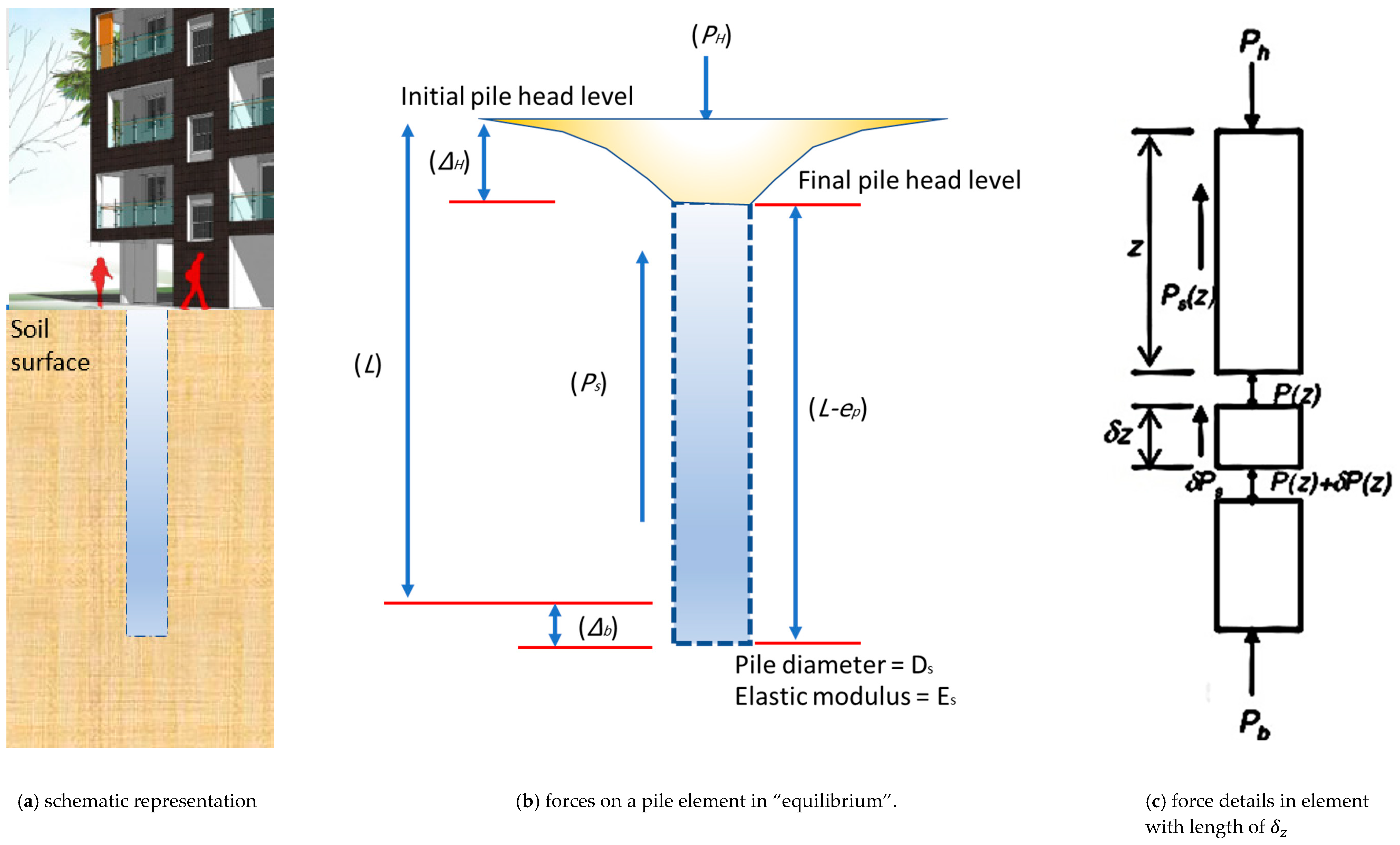
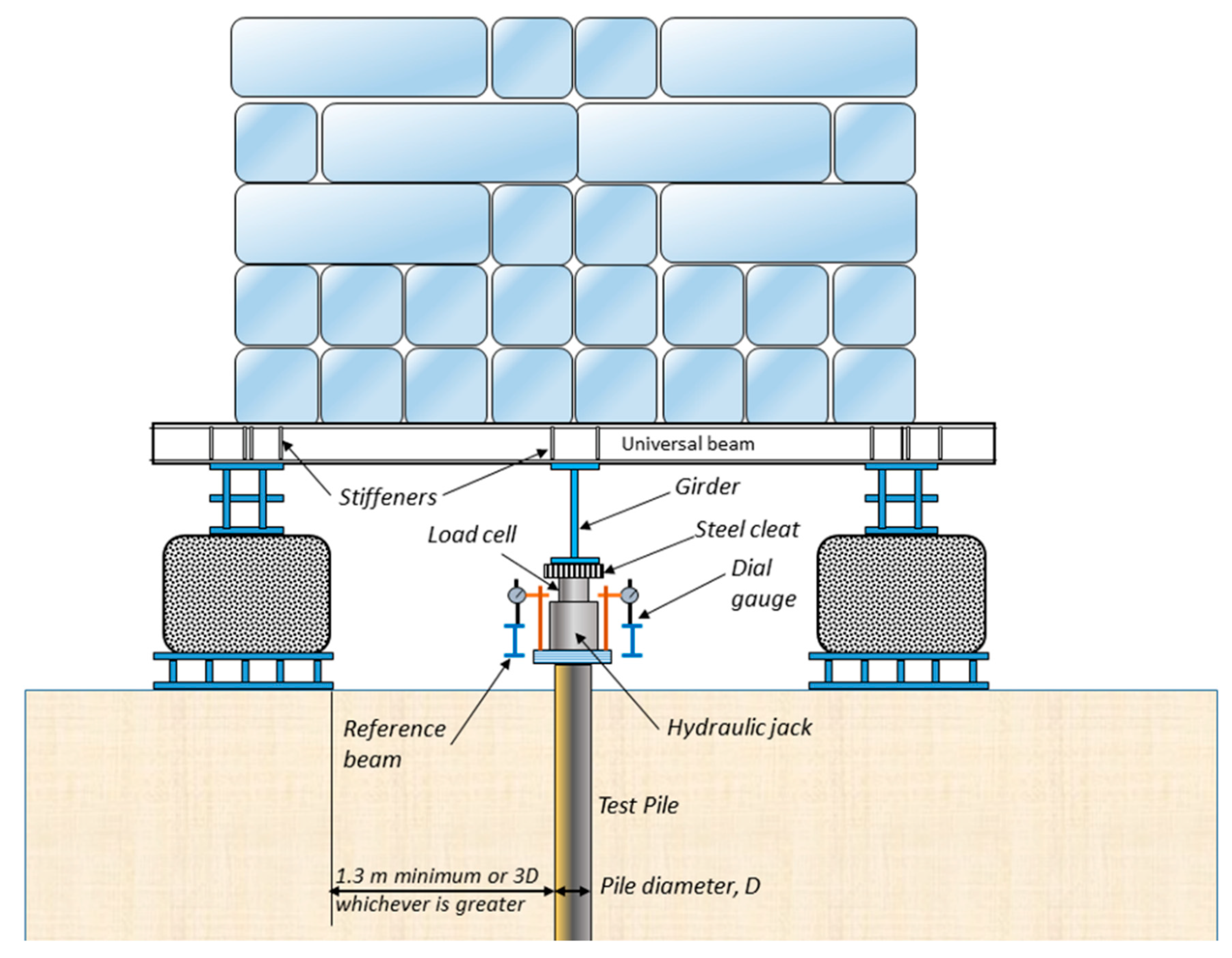
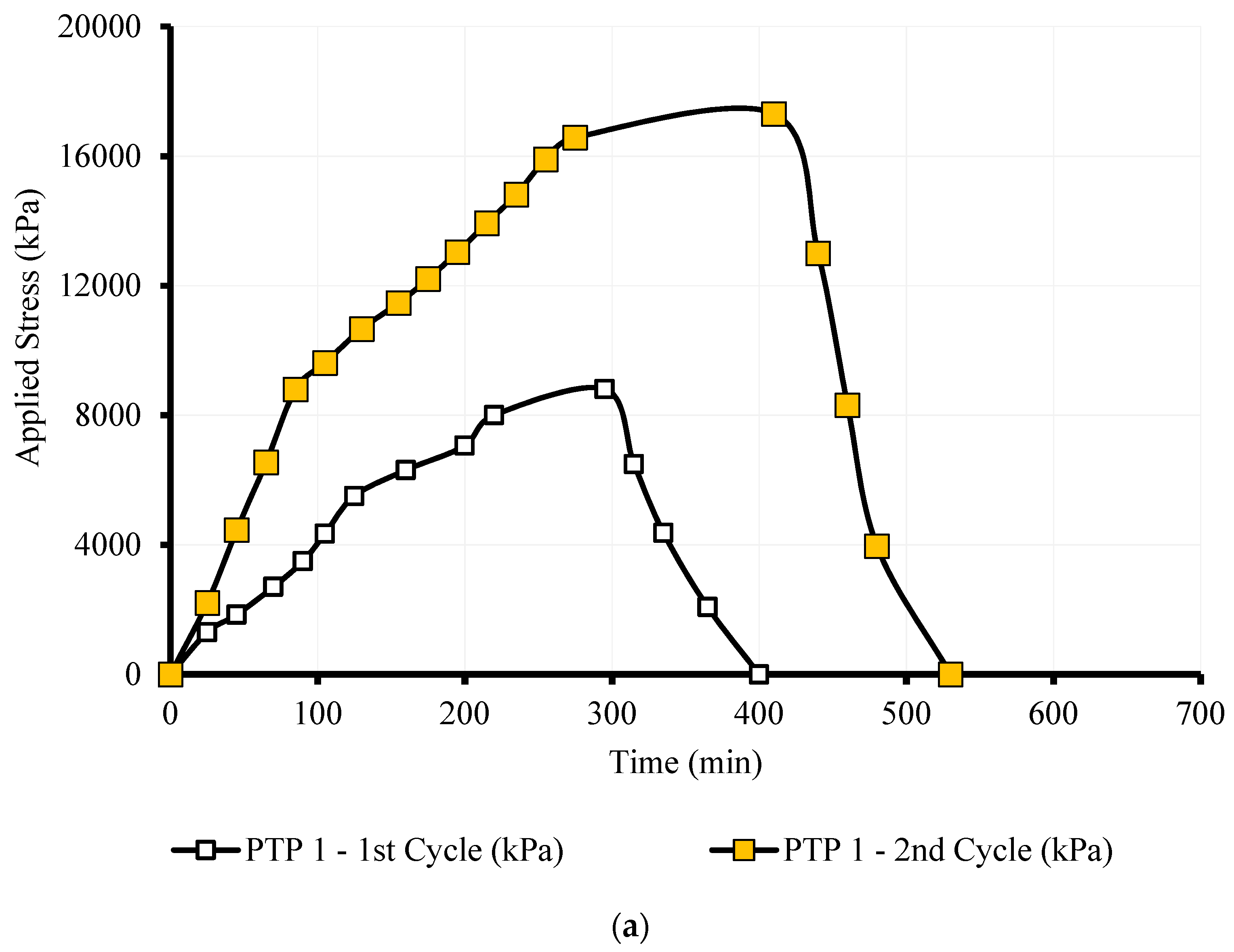
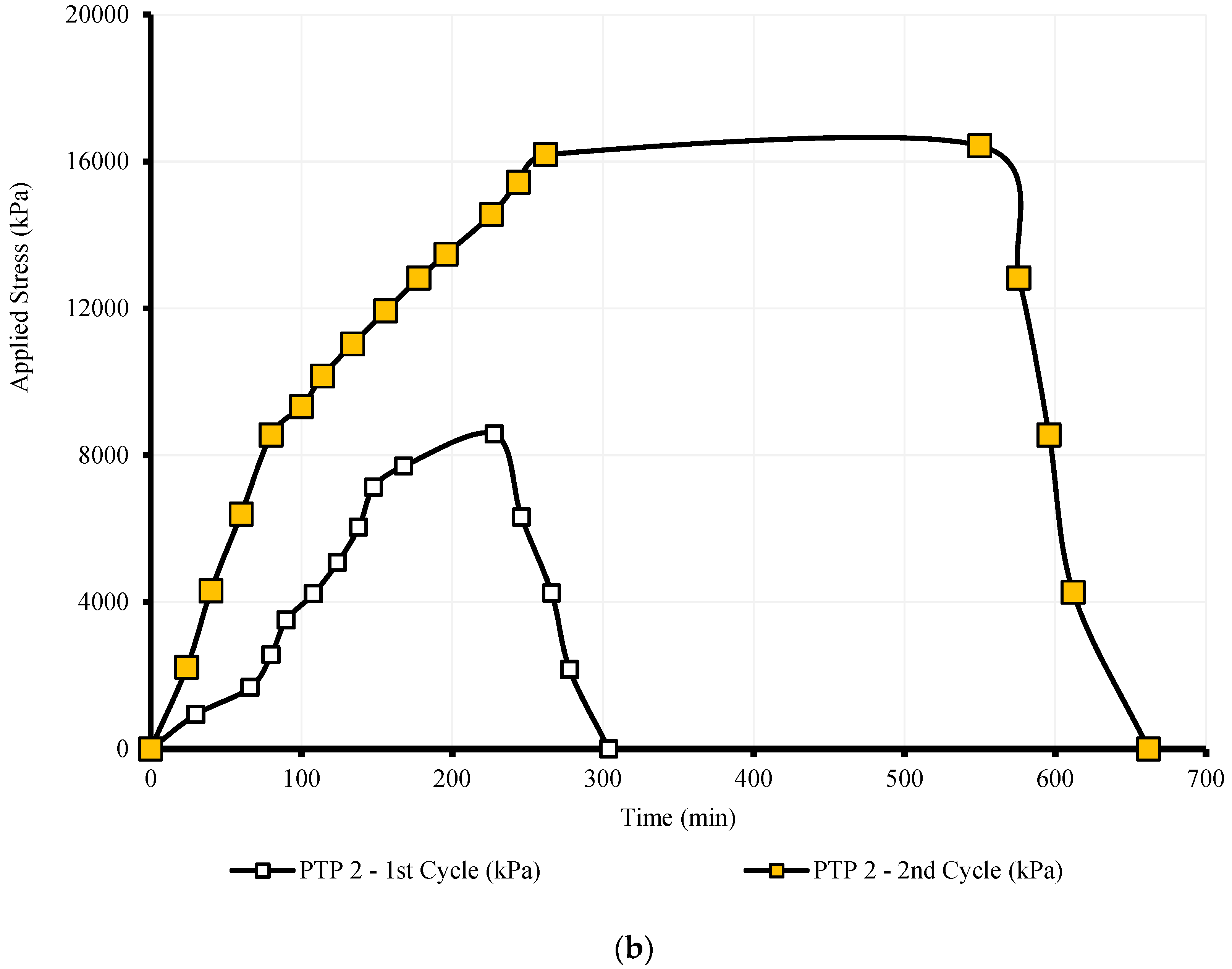
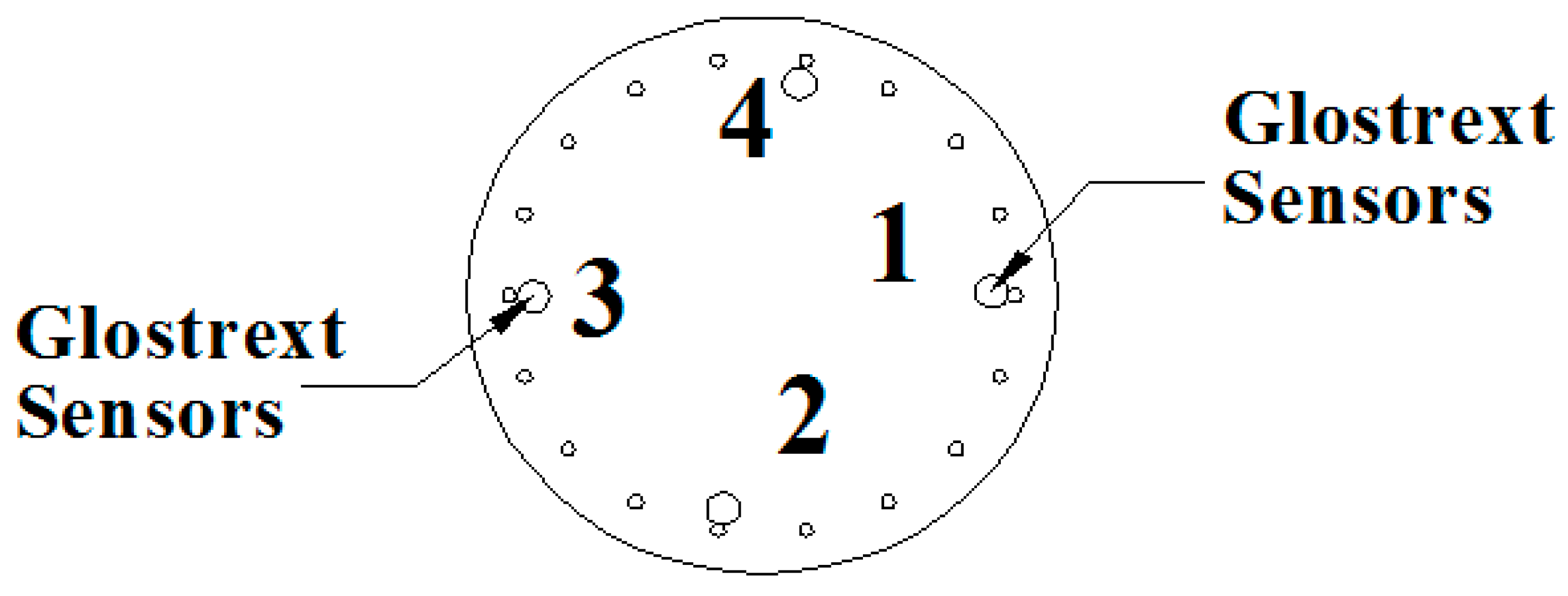
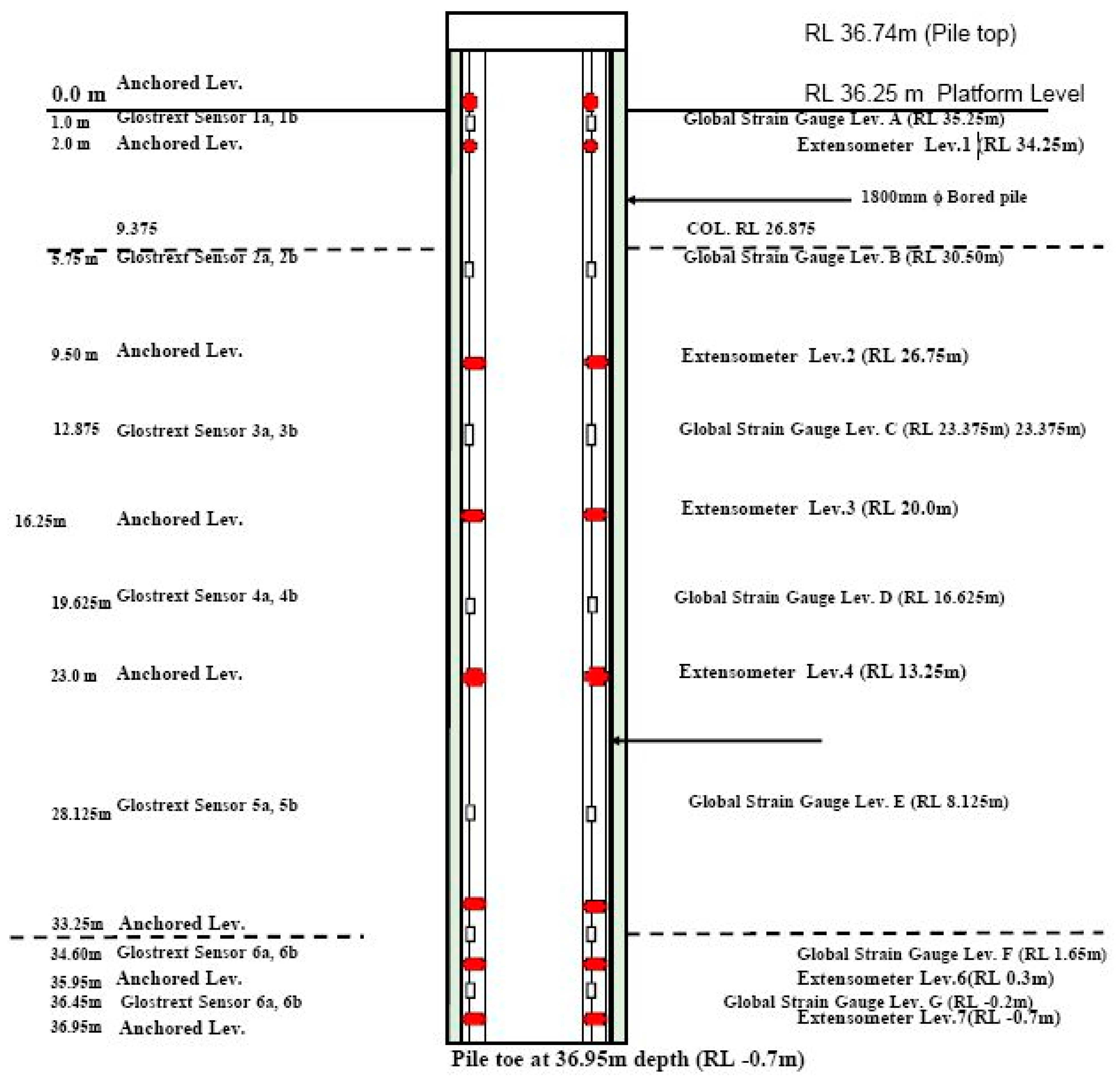
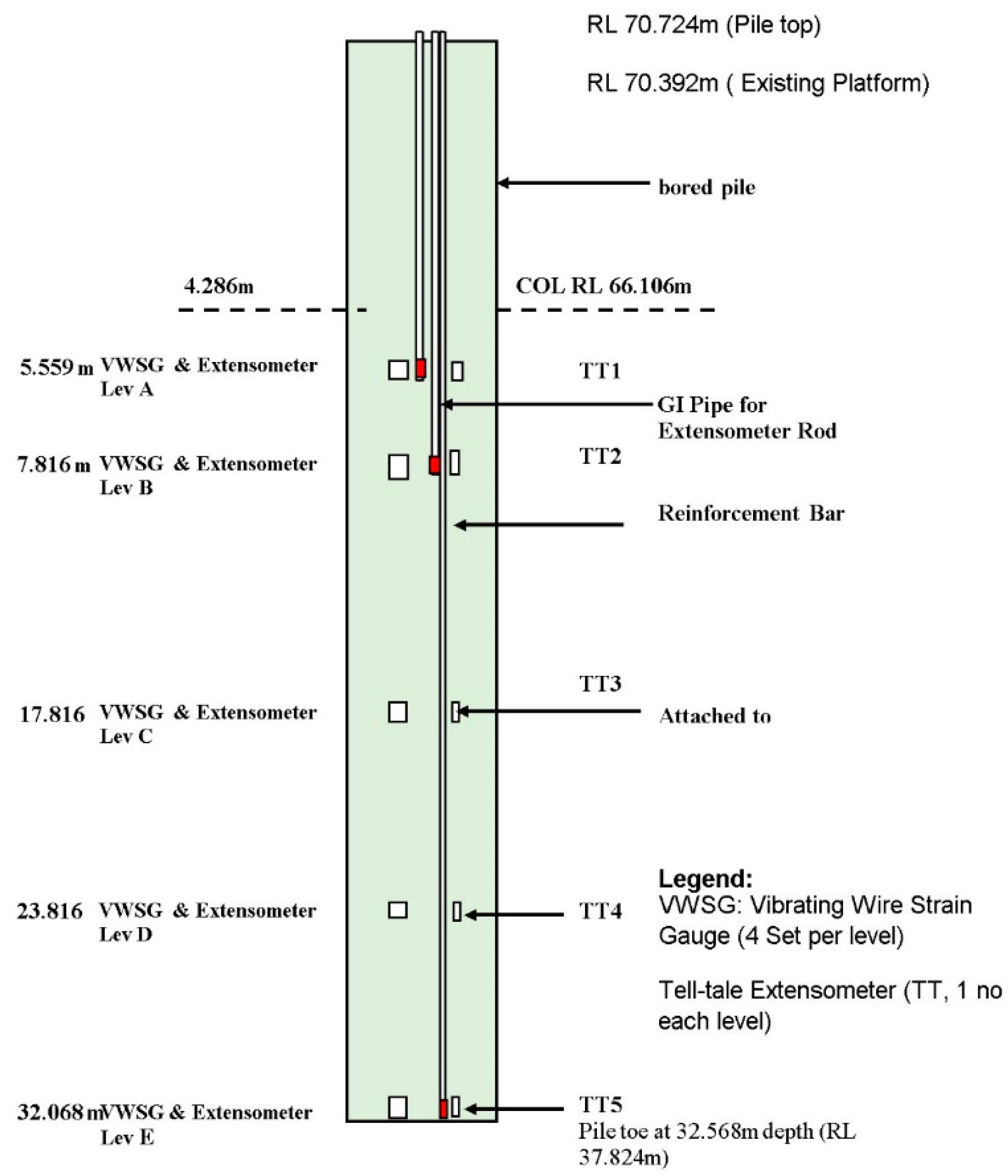

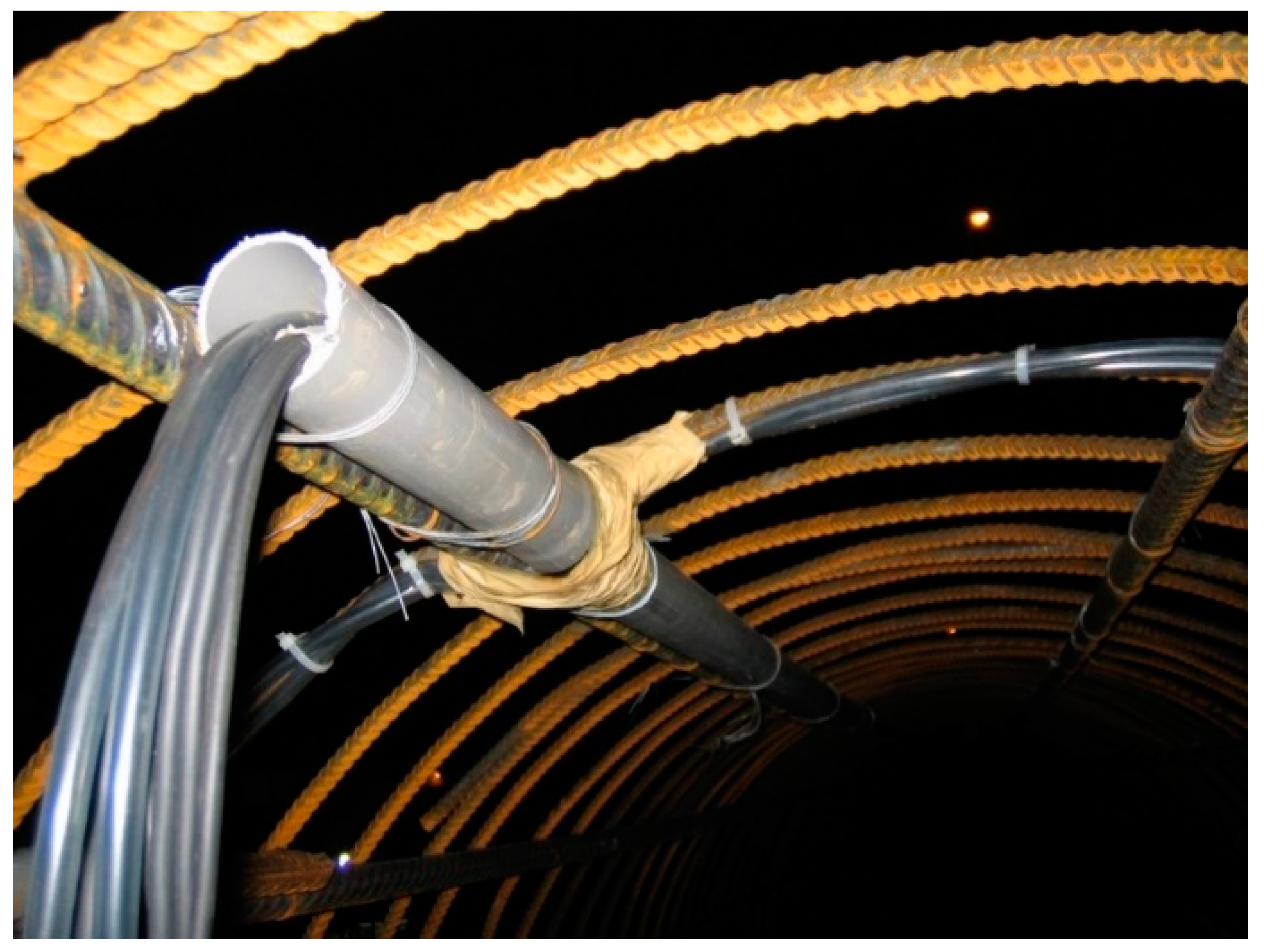
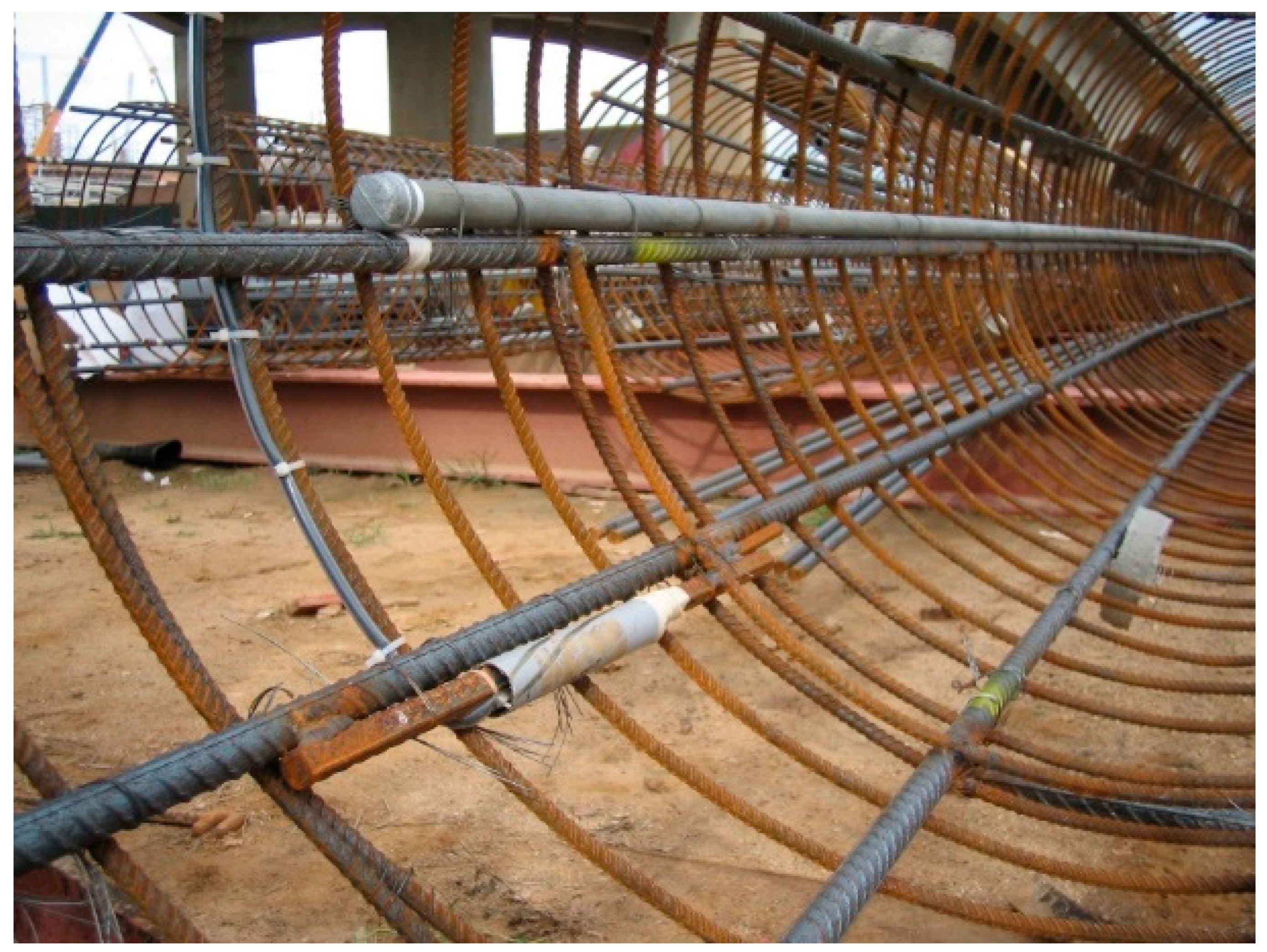
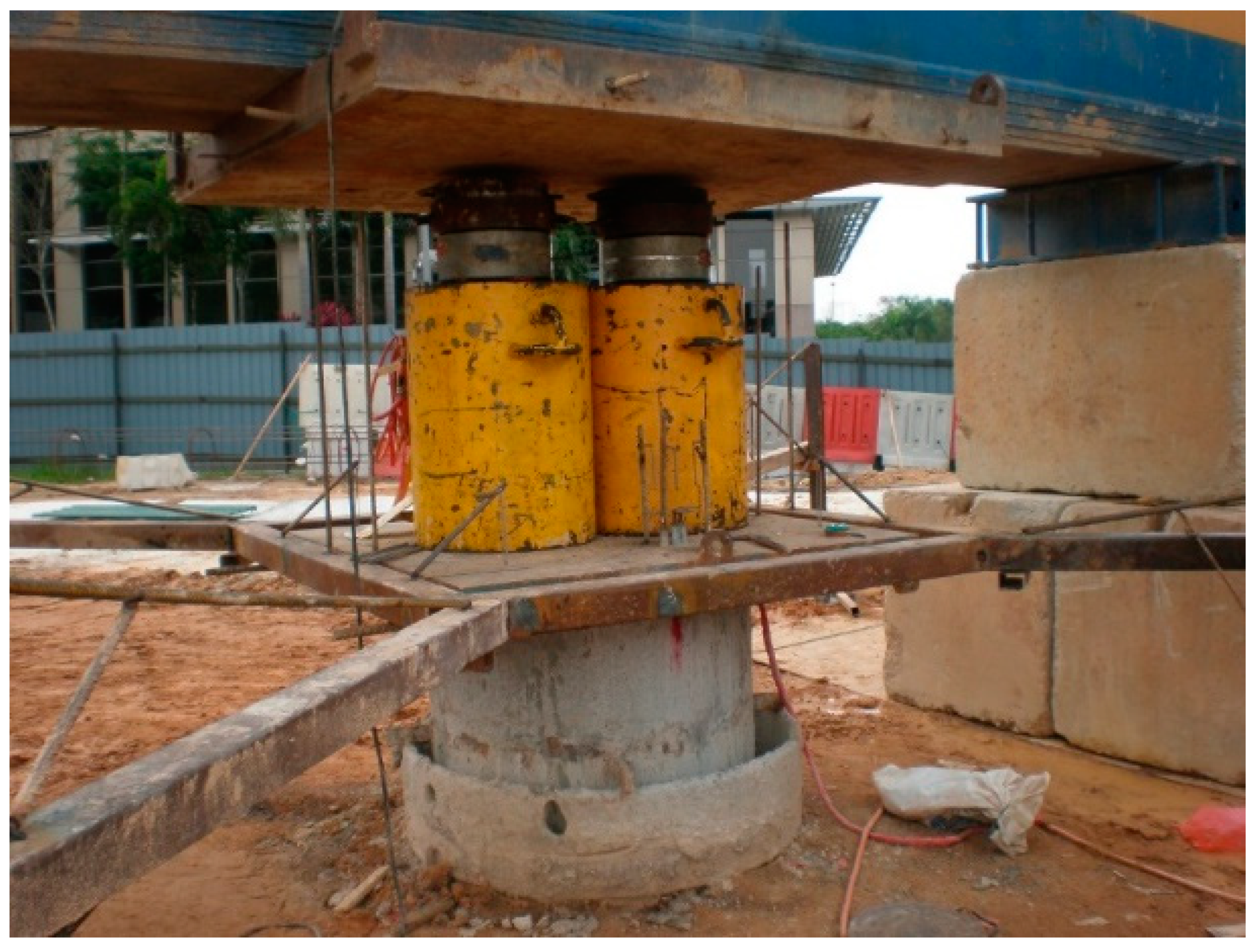
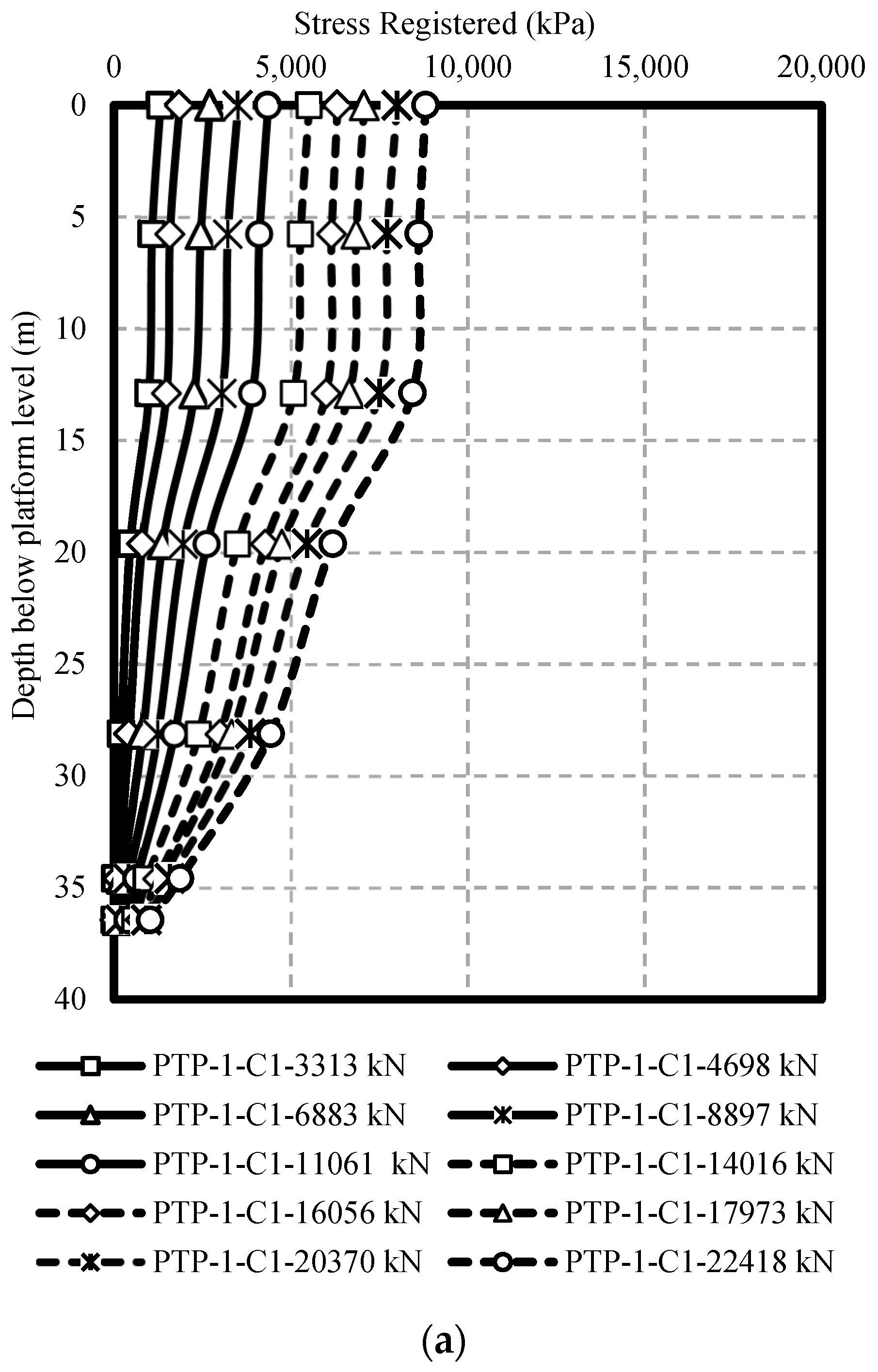

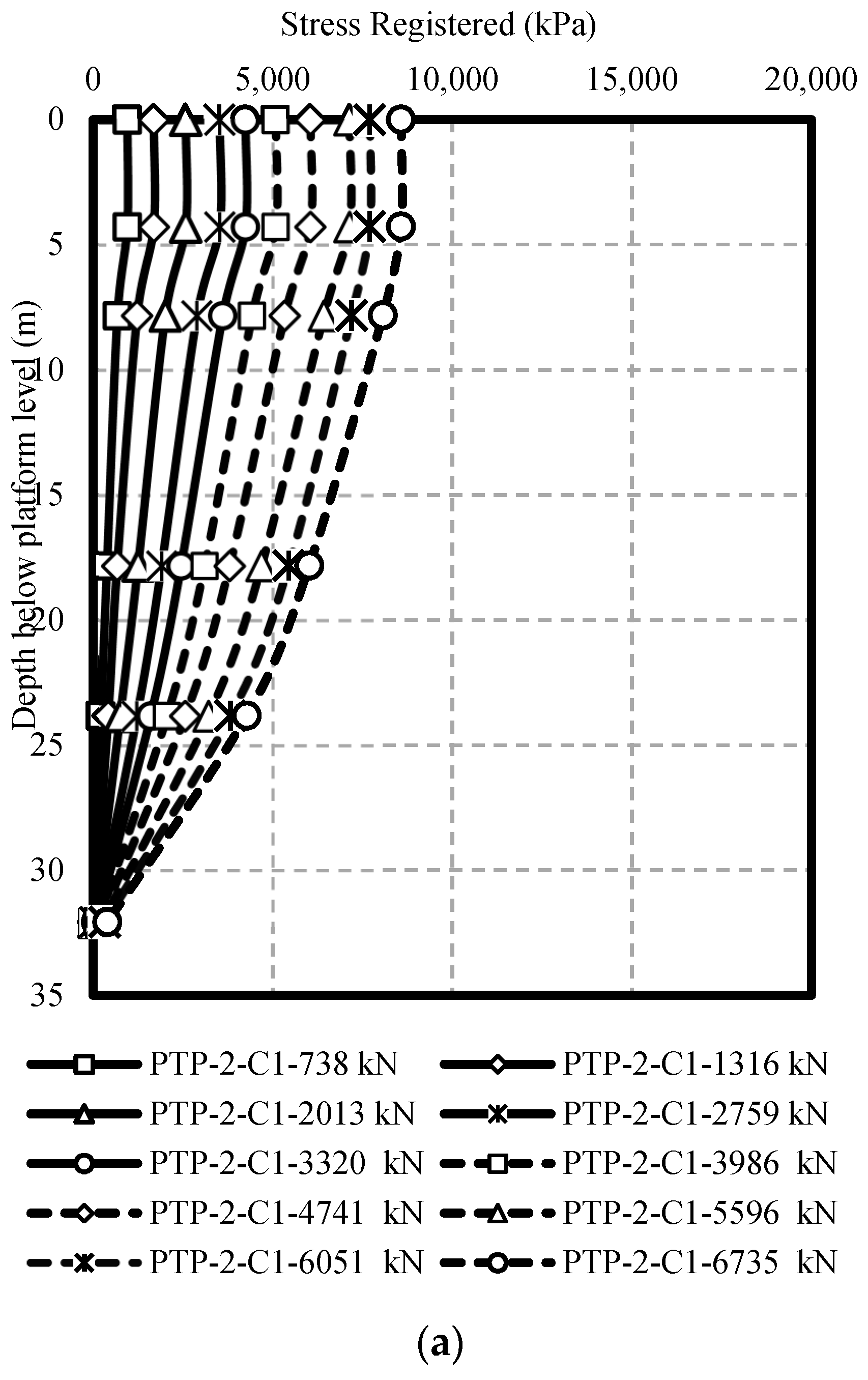
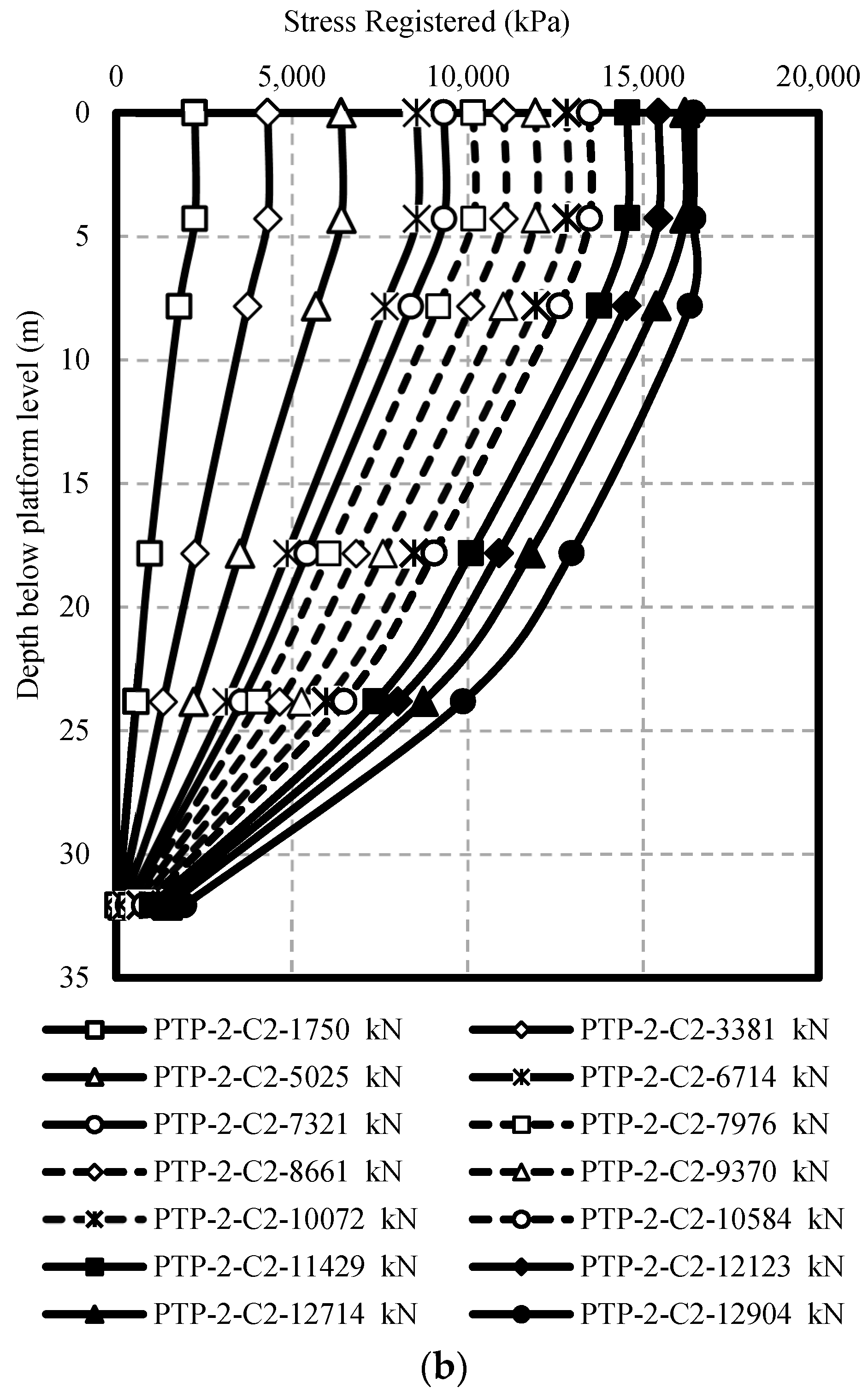

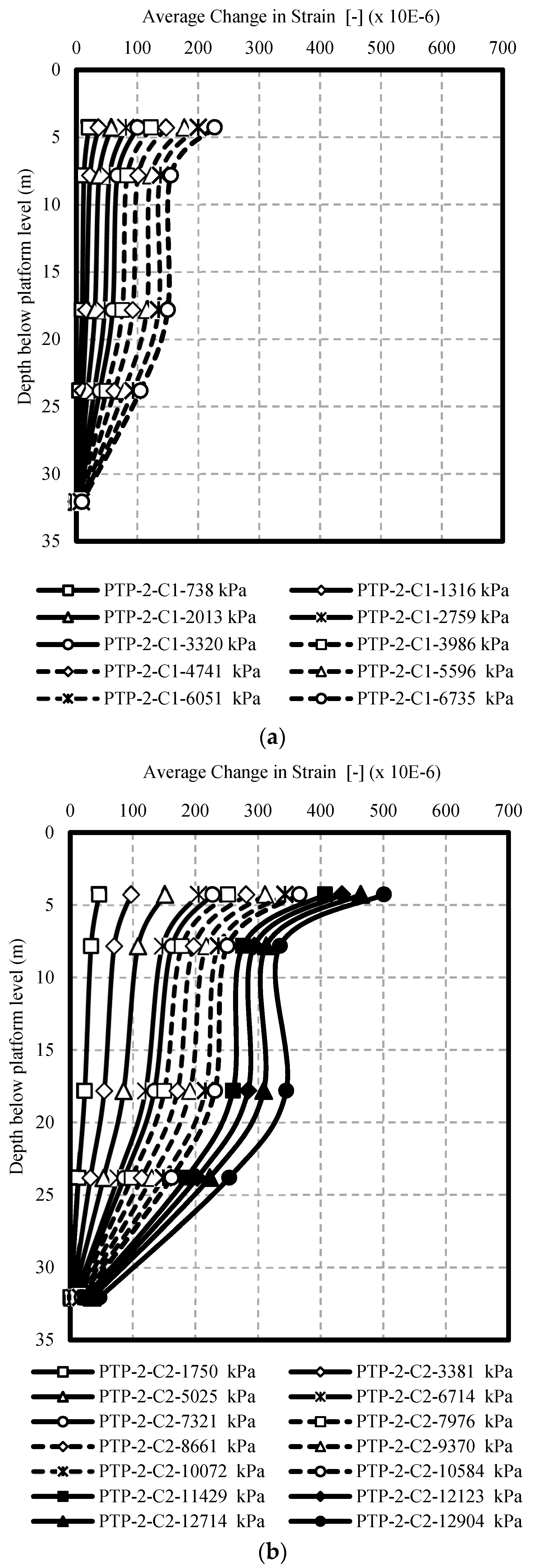
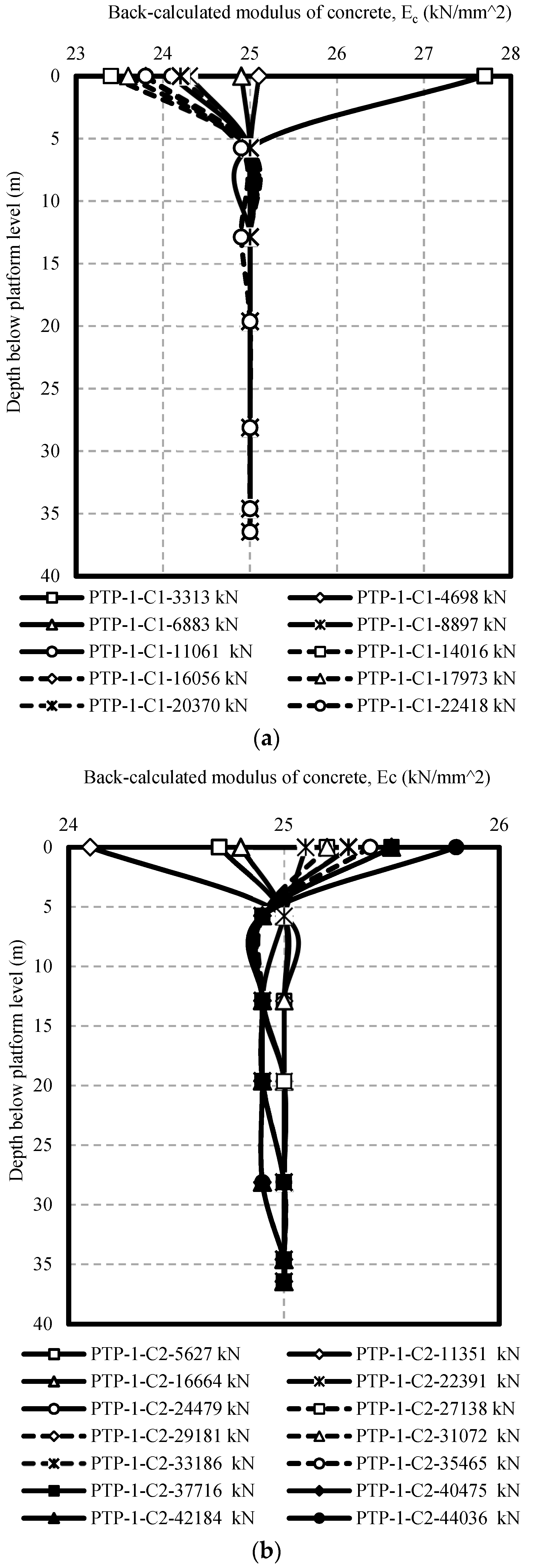

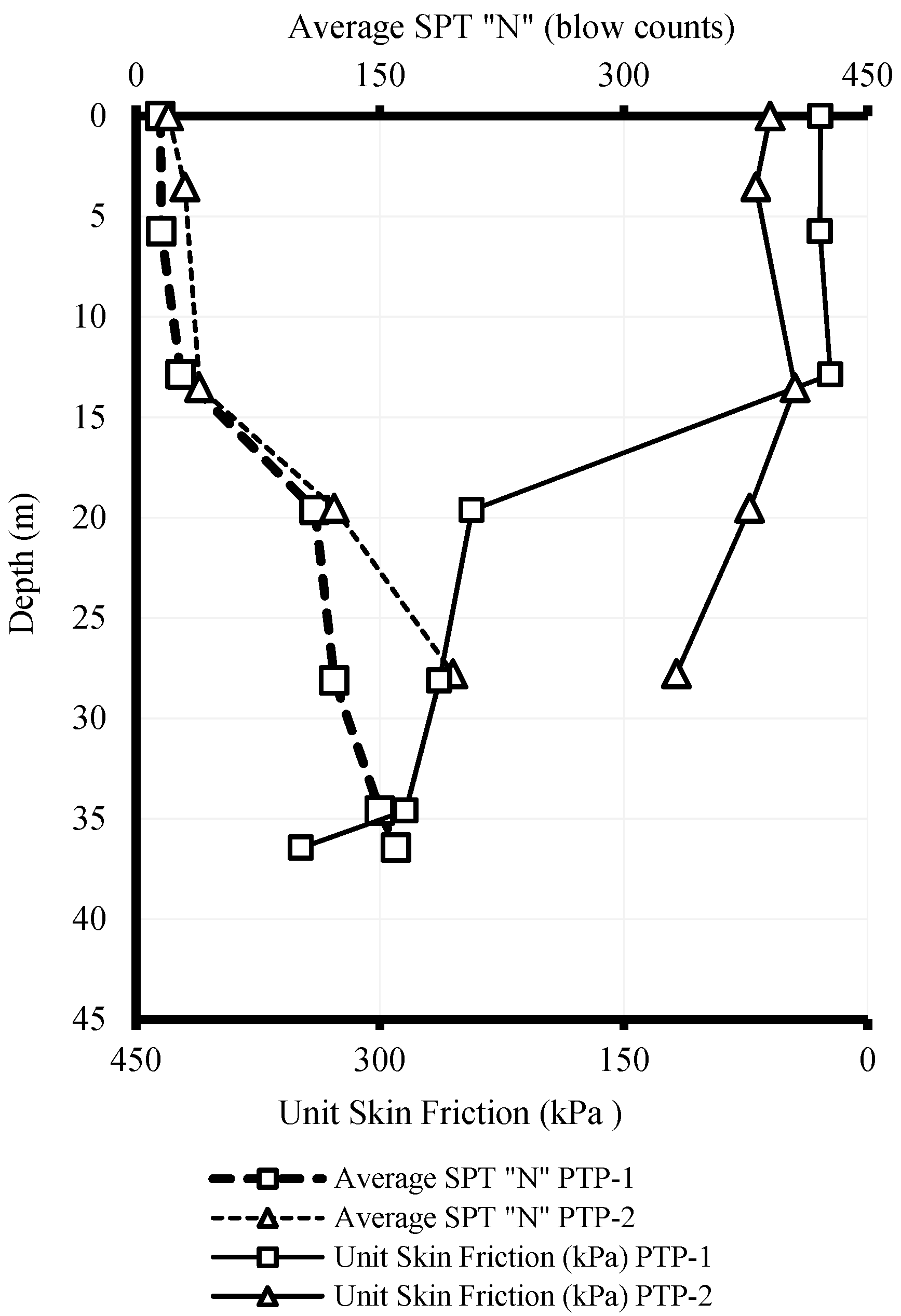


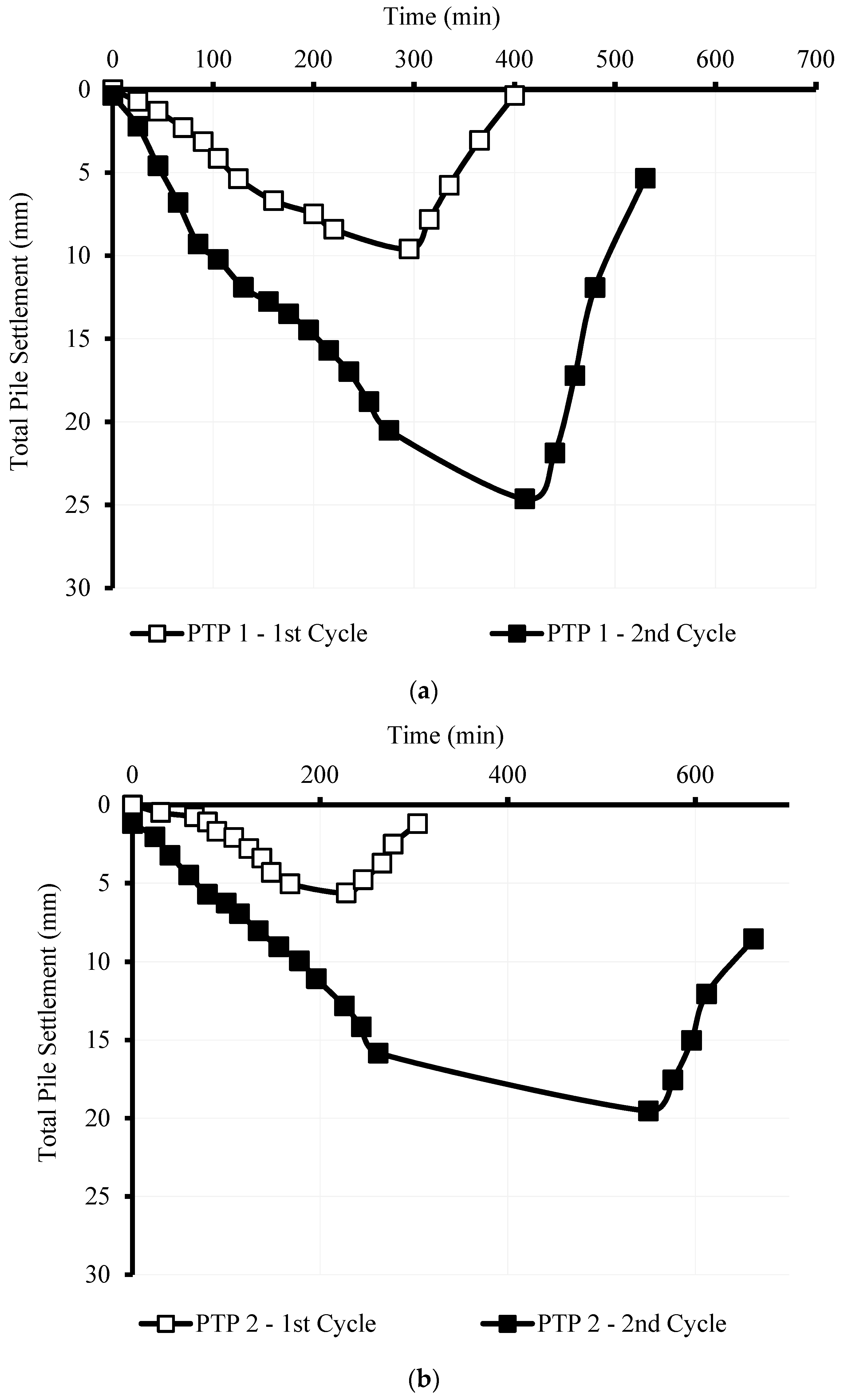
| Pile No | Diameter (mm) | Working Load (kN) | Pile Length (m) | Pile Area (m2) | Test Load (kN) | Type of Instrument |
|---|---|---|---|---|---|---|
| BP# 1 | 1800 | 22,200 | 36.95 | 2.5447 | 44,400 | GSE |
| BP# 2 | 1000 | 6750 | 32.56 | 0.7854 | 13,500 | Conventional |
| Test Pile | Soil Stratum | Depth (m) | SPT-N Values * | Average SPT-N | |
|---|---|---|---|---|---|
| BP# 1 | L1 | Stiff Sandy Silt with little gravel | 0–8 | 3–16 | 15.50 |
| L2 | Very Stiff Sandy Silt with little gravel | 8–10 | 16–50 | 27.5 | |
| L3 | Hard Yellowish Sandy Silt with little gravel | 10–17 | 50–111 | 110 | |
| L4 | Hard Yellowish Sandy Silt with little gravel | 17–24 | 111–150 | 122 | |
| L5 | Fractured limestone | 24–36.95 | 143–150 | 150 | |
| BP# 2 | L1 | Sandy SILT | 0–12 | 4–30 | 30 |
| L2 | Sandy CLAY | 12–17 | 19–39 | 39 | |
| L3 | SILT | 18–23 | 54–125 | 122 | |
| L4 | Weathered Sandstone | 25–31.65 | 176–200 | 195 |
© 2019 by the authors. Licensee MDPI, Basel, Switzerland. This article is an open access article distributed under the terms and conditions of the Creative Commons Attribution (CC BY) license (http://creativecommons.org/licenses/by/4.0/).
Share and Cite
Moayedi, H.; Kalantar, B.; Abdullahi, M.M.; Rashid, A.S.A.; Nazir, R.; Nguyen, H. Determination of Young Elasticity Modulus in Bored Piles Through the Global Strain Extensometer Sensors and Real-Time Monitoring Data. Appl. Sci. 2019, 9, 3060. https://doi.org/10.3390/app9153060
Moayedi H, Kalantar B, Abdullahi MM, Rashid ASA, Nazir R, Nguyen H. Determination of Young Elasticity Modulus in Bored Piles Through the Global Strain Extensometer Sensors and Real-Time Monitoring Data. Applied Sciences. 2019; 9(15):3060. https://doi.org/10.3390/app9153060
Chicago/Turabian StyleMoayedi, Hossein, Bahareh Kalantar, Mu’azu Mohammed Abdullahi, Ahmad Safuan A. Rashid, Ramli Nazir, and Hoang Nguyen. 2019. "Determination of Young Elasticity Modulus in Bored Piles Through the Global Strain Extensometer Sensors and Real-Time Monitoring Data" Applied Sciences 9, no. 15: 3060. https://doi.org/10.3390/app9153060
APA StyleMoayedi, H., Kalantar, B., Abdullahi, M. M., Rashid, A. S. A., Nazir, R., & Nguyen, H. (2019). Determination of Young Elasticity Modulus in Bored Piles Through the Global Strain Extensometer Sensors and Real-Time Monitoring Data. Applied Sciences, 9(15), 3060. https://doi.org/10.3390/app9153060





